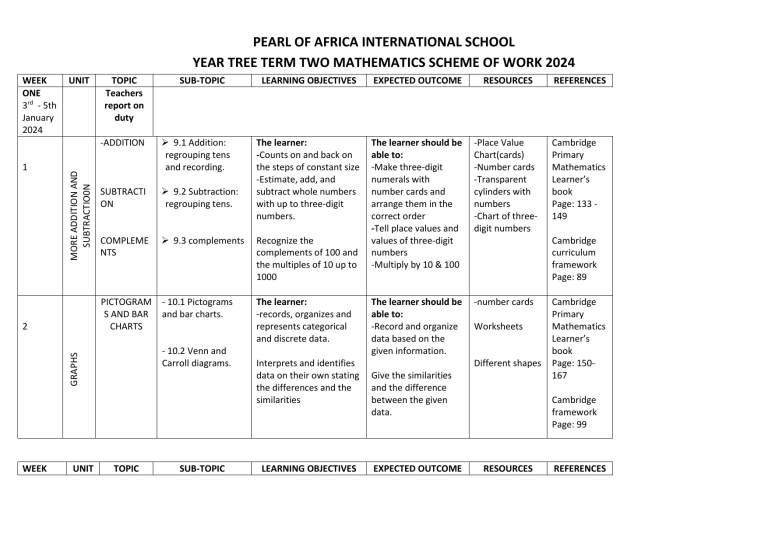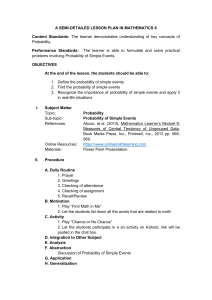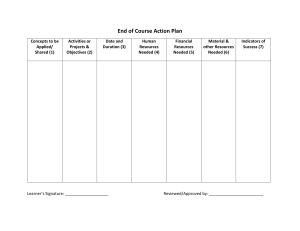
PEARL OF AFRICA INTERNATIONAL SCHOOL YEAR TREE TERM TWO MATHEMATICS SCHEME OF WORK 2024 1 UNIT MORE ADDITION AND SUBTRACTIO0N WEEK ONE 3rd - 5th January 2024 WEEK UNIT SUB-TOPIC LEARNING OBJECTIVES EXPECTED OUTCOME RESOURCES REFERENCES The learner: -Counts on and back on the steps of constant size -Estimate, add, and subtract whole numbers with up to three-digit numbers. The learner should be able to: -Make three-digit numerals with number cards and arrange them in the correct order -Tell place values and values of three-digit numbers -Multiply by 10 & 100 -Place Value Chart(cards) -Number cards -Transparent cylinders with numbers -Chart of threedigit numbers Cambridge Primary Mathematics Learner’s book Page: 133 149 The learner should be able to: -Record and organize data based on the given information. -number cards -ADDITION 9.1 Addition: regrouping tens and recording. SUBTRACTI ON 9.2 Subtraction: regrouping tens. COMPLEME NTS 9.3 complements Recognize the complements of 100 and the multiples of 10 up to 1000 PICTOGRAM S AND BAR CHARTS - 10.1 Pictograms and bar charts. The learner: -records, organizes and represents categorical and discrete data. - 10.2 Venn and Carroll diagrams. GRAPHS 2 TOPIC Teachers report on duty TOPIC SUB-TOPIC Interprets and identifies data on their own stating the differences and the similarities LEARNING OBJECTIVES Cambridge curriculum framework Page: 89 Worksheets Different shapes Give the similarities and the difference between the given data. EXPECTED OUTCOME Cambridge Primary Mathematics Learner’s book Page: 150167 Cambridge framework Page: 99 RESOURCES REFERENCES MORE MULTIPLICATION AND DIVISION 3 MULTIPLI CATION DIVISION 11.1 Revisiting multiplication and division. 11.2 playing with multiplication and division. 11.3 Extending multiplication and division. FRACTION S 12.1 Fractions of numbers. 12.2 Ordering and comparing fractions. MORE FRACTIONS 4 12.3 Calculating with fractions. The learner: -Tells the meaning of halves and doubles -Halves and doubles off numbers correctly -Identifies numbers halved and doubled to get given numbers in the questions -Applies the knowledge of halves and doubles to solve word problems Count on and backward in the steps of constant size to support the calculating The learner should be able to: -Double and halve numbers correctly The learner: -understands and explains fractions can describe equal parts of a quantity or a set of objects. - recognizes that two fractions can have an equivalent value (halves, quarters, fifths, and tenths). The learner should be able to: -describe the equal parts of an object -Estimate, add, and subtract fractions with the same denominator within a whole Subtract fractions within one whole -Solve simple word problems that require doubling and halving -Explain how doubling and halving is the same as addition and subtraction Recognize the equivalent fractions -Number cards showing doubles and halves of numbers -Doubling tables e.g. 2x , 4x and 8x tables -Doubling sequences of number cards Fraction strips Scissors Beads Elastic or thread for the bracelets Cambridge Primary Mathematics Learner’s book Page: 168 182 Cambridge Primary Mathematics Teacher’s Resource Page: 133 145 Cambridge Primary Mathematics Learner’s book Page: 183 199 Cambridge Primary Mathematics Teacher’s Resource Page: 146 160 WEEK UNIT TOPIC SUB-TOPIC 13.1 Mass. The learner; MEASURE MEASURES 13.2 capacity. 5 LEARNING OBJECTIVES 13.3 temperature. -Use instruments that measure mass and estimate and measure the mass of objects in grams and kilograms. EXPECTED OUTCOME The learner should be able to: -measure and estimate objects using grams and kilograms, RESOURCES thermometer -buckets drawn on the board ltres and, milliliters. -estimate and measure objects in litres and ml measure temperature and record their findings HALF TERM BREAK 6 WEEK Cambridge Primary Mathematics Learner’s book Page: 200 222 Cambridge Primary Mathematics Teacher’s Resource Page: 1165 173 -use instruments that -use instruments that measure temperature. REFERENCES UNIT TOPIC SUB-TOPIC LEARNING OBJECTIVES EXPECTED OUTCOME RESOURCES REFERENCES 14.1 Time The calendar The learner; -Reads and tells time on digital and analogue clocks correctly 14.2 Timetables -Differentiates between analogue and digital time Digital clocks TIME TIME 2 7 AND 8 Time intervals -Converts 12hour clock system to 24-hour clock system 9 2B: MEASURE & PROBLEM SOLVING -Solves word problems on travel timetables of buses, trains, and aircraft Estimating Calculating with and money measures More calculation with money (1 $2) Revisiting money The learner; -Reads and recognizes equivalent money values in dollars -Adds and subtracts small denominations of money involving cents -Reads and interprets word problems involving buying and selling with a balance The learner should be able to: -Read and tell time -Calendars -Scrambled word cards -Convert time from 24-hour to 12-hour systems and vice versa -Meter ruler, classroom ruler -Distinguish between analog and digital -Weighing scale time -Display charts -Solve word problems for length, mass, involving time and capacity The learner should be able to: - Add and subtract small denominations of money involving cents -Add and subtract small denominations of money involving cents -Read and interpret word problems involving buying and selling with a balance Cambridge Primary Mathematics Learner’s book Page: 223235 Cambridge Primary Mathematics Teacher’s Resource Page: 177182 Cambridge -Notes and coins Primary of dollars Mathematics (representation) Learner’s book -Small items for Page: 36 - 52 sell Cambridge -A chart of Primary different Mathematics denominations Teacher’s of money Resource Page: 49- 61 WEEK UN IT TOPIC 10 2B: MEASURE & PROBLEM SOLVING Revisiting Handling of data and problem solving SUB-TOPIC LEARNING OBJECTIVES EXPECTED OUTCOME RESOURCES REFERENCES Venn diagrams The learner; -Reads and interprets data on a Venn diagram The learner should be able to: -Read and interpret information on a bar chart to solve word problems involved. -Display Bar graphs and pictograms, Frequency tables and Venn diagrams to show data Cambridge Primary Mathematics Learner’s book Page: 80-87 Tallies Pictograms Bar charts -Uses the Venn diagram to sort numbers or objects according to their features -Tallies and represents the data on a frequency table and bar graphs Reads and interprets information on a bar chart to solve word problems involved. -Tally and represent the data in a frequency table and on bar graphs -Use a Venn diagram to sort numbers or objects according to their features -Mathematical set instruments -Interlocking cubes (2D shapes) Cambridge Primary Mathematics Teacher’s Resource Page: 159170


